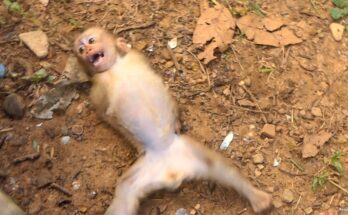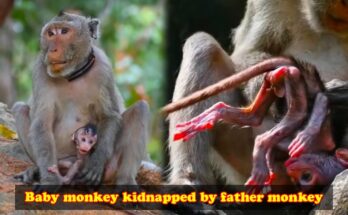The jungle fell silent the day the little monkey vanished — a tiny body ripped from the safety of the troop and dragged into shadow by a cruel, larger monkey whose teeth and fists knew only domination. “Rescue the poor little monkey that was kidnapped and tortured by the bad monkey” is a story of pain, bravery, and the stubborn, healing light of compassion that refuses to look away.
When the rescue began, the forest was thick with fear. The troop huddled in the canopy, eyes wide and voices low, while a handful of brave friends — older monkeys, a vigilant macaque named Sori, and two humans who had watched the troop for years — set out to follow the trail. The path they found told a hard tale: broken branches, scuffed earth, and the faint, heartbreaking imprint of small hands. Anxiety tightened every chest, but determination beat stronger. They would find the little one.
Discovery was ugly but necessary. Hidden beneath a tangle of vines and bruised leaves, the monkey lay small and shivering, eyes clouded with pain. The “bad monkey” had left him broken in body and spirit, but not entirely defeated. Rescue was gentle and immediate. Hands that had once clung to branches now reached out in kindness, lifting the fragile creature into warmth and safety. The rescue team carried him back through the replay of soft alarms and relieved chattering, every step a vow: you won’t be left alone.
Healing began in a clearing beside a stream where sunlight dappled the ground. They cleaned his wounds with herbs and water, wrapped his body with leaves and careful hands, and fed him mashed fruit until his belly remembered fullness. The real work was harder — fixing what the eye couldn’t see. They soothed his nightmares with quiet songs, kept watch over his restless nights, and let him sleep near a motherly figure whose steady breathing became a metronome of safety. Each gentle touch and patient hour rewove lost threads of trust.
The troop watched and learned. The older monkeys brought fruit and protection. The younger ones, once startled, returned to playfulness under careful supervision. Slowly, the rescued monkey stood taller. His steps were hesitant at first, but each wobble turned more confident as muscles remembered how to climb, arms found rhythm, and laughter crept back like a shy sun. The rescue became more than a single act; it became a communal reclaiming of what cruelty had tried to erase.
This story is a reminder that even in the face of cruelty, community can be a powerful antidote. It speaks to the importance of watching, protecting, and acting — of not letting suffering slide into the shadows. The little monkey’s recovery did not erase the trauma overnight, but it showed the world that wounds can be healed when hands, hearts, and voices come together.
“Rescue the poor little monkey that was kidnapped and tortured by the bad monkey” ends not with a clean, fairy-tale happy ever after, but with steady, honest hope: scars that tell a story of survival, a troop that grew stronger for its care, and a tiny life that, against the odds, chose to climb again.


